Preemption
Preemption is an essential feature found in most schedulers, and it plays a crucial role in enabling key system functionalities like DaemonSets in K8s, as well as SLA and prioritization-based features.
This document provides a brief introduction to the concepts and configuration methods of preemption in YuniKorn. For a more comprehensive understanding of YuniKorn's design and practical ideas related to preemption, please refer to the design document.
Kubernetes Preemption
Preemption in Kubernetes operates based on priorities. Starting from Kubernetes 1.14, you can configure preemption by adding a preemptionPolicy to the PriorityClass. However, it is important to note that preemption in Kubernetes is solely based on the priority of the pod during scheduling. The full documentation can be found here.
While Kubernetes does support preemption, it does have some limitations. Preemption in Kubernetes only occurs during the scheduling cycle and does not change once the scheduling is complete. However, when considering batch or data processing workloads, it becomes necessary to account for the possibility of opting out at runtime.
YuniKorn Preemption
In Yunikorn, we offer two preemption types: general and DaemonSet. DaemonSet preemption is much more straightforward, as it ensures that pods which must run on a particular node are allowed to do so. The rest of the documentation only concerns generic preemption. For a comprehensive explanation of DaemonSet preemption, please consult the design document.
YuniKorn's generic preemption is based on a hierarchical queue model, enabling pods to opt out of running. Preemption is triggered after a specified delay, ensuring that each queue's resource usage reaches at least the guaranteed amount of resources. To configure the delay time for preemption triggering, you can utilize the preemption.delay property in the configuration.
To prevent the occurrence of preemption storms or loops, where subsequent preemption tasks trigger additional preemption tasks, we have designed seven preemption laws. These laws are as follows:
- Preemption policies are strong suggestions, not guarantees
- Preemption can never leave a queue lower than its guaranteed capacity
- A task cannot preempt other tasks in the same application
- A task cannot trigger preemption unless its queue is under its guaranteed capacity
- A task cannot be preempted unless its queue is over its guaranteed capacity
- A task can only preempt a task with lower or equal priority
- A task cannot preempt tasks outside its preemption fence
For a detailed explanation of these preemption laws, please refer to the preemption design document.
Next, we will provide a few examples to help you understand the functionality and impact of preemption, allowing you to deploy it effectively in your environment. You can find the necessary files for the examples in the yunikorn-k8shim/deployments/examples/preemption directory.
Included in the files is a YuniKorn configuration that defines the queue configuration as follows:
queues.yaml: |
partitions:
- name: default
placementrules:
- name: provided
create: true
queues:
- name: root
submitacl: '*'
properties:
preemption.policy: fence
preemption.delay: 10s
queues:
- name: 1-normal ...
- name: 2-no-guaranteed ...
- name: 3-priority-class ...
- name: 4-priority-queue ...
- name: 5-fence ...
Each queue corresponds to a different example, and the preemption will be triggered 10 seconds after deployment, as indicated in the configuration preemption.delay: 10s.
General Preemption Case
In this case, we will demonstrate the outcome of triggering preemption when the queue resources are distributed unevenly in a general scenario.
We will deploy 10 pods with a resource requirement of 1 to both queue-1 and queue-2. First, we deploy to queue-1 and then introduce a few seconds delay before deploying to queue-2. This ensures that the resource usage in queue-1 will exceed that of queue-2, depleting all resources in the parent queue and triggering preemption.
| Queue | Max Resource | Guaranteed Resource |
|---|---|---|
normal | 12 | - (not configured) |
normal.queue-1 | 10 | 5 |
normal.queue-2 | 10 | 5 |
Result:
When a set of guaranteed resources is defined, preemption aims to ensure that all queues satisfy their guaranteed resources. Preemption stops once the guaranteed resources are met (law 4). A queue may be preempted if it has more resources than its guaranteed amount. For instance, in this case, if queue-1 has fewer resources than its guaranteed amount (<5), it will not be preempted (law 5).
| Queue | Resource before preemption | Resource after preemption |
|---|---|---|
normal.queue-1 | 10 (victim) | 7 |
normal.queue-2 | 2 | 5 (guaranteed minimum) |
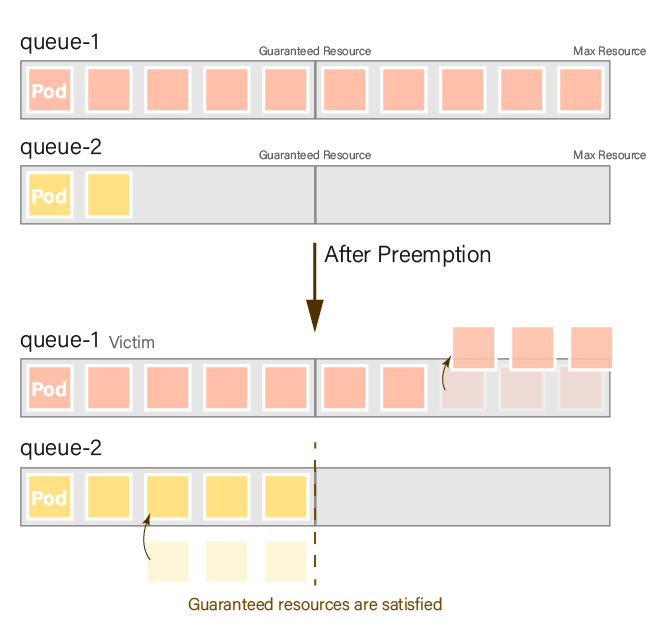
Priority
In general, a pod can preempt a pod with equal or lower priority. You can set the priority by defining a PriorityClass or by utilizing queue priorities.
While preemption allows service-type pods to scale up or down through preemption, it can also lead to the preemption of pods that should not be preempted in certain scenarios:
- Spark Jobs, where the driver pod manages a large number of jobs, and if preempted, all jobs will be affected.
- Interactive pods, such as Python notebooks, have a significant impact when restarted and should be avoided from preemption.
To address this issue, we have designed a "do not preempt me" flag. You can set the annotation yunikorn.apache.org/allow-preemption to false in the PriorityClass to prevent pod requests from being preempted.
NOTE: The flag
yunikorn.apache.org/allow-preemptionis a request only. It is not guaranteed but Pods annotated with this flag will be preempted last.
PriorityClass
In this example, we will demonstrate the configuration of yunikorn.apache.org/allow-preemption using PriorityClass and observe its effect. The default value for this configuration is set to true.
apiVersion: scheduling.k8s.io/v1
kind: PriorityClass
metadata:
name: preemption-not-allow
annotations:
"yunikorn.apache.org/allow-preemption": "false"
value: 0
We will deploy 8 pods with a resource requirement of 1 to queue-1, queue-2, and queue-3, respectively. We will deploy to queue-1 and queue-2 first, followed by a few seconds delay before deploying to queue-3. This ensures that the resource usage in queue-1 and queue-2 will be greater than that in queue-3, depleting all resources in the parent queue and triggering preemption.
| Queue | Max Resource | Guaranteed Resource | allow-preemption |
|---|---|---|---|
rt | 16 | - | |
rt.queue-1 | 8 | 3 | true |
rt.queue-2 | 8 | 3 | false |
rt.queue-3 | 8 | 3 | true |
Result:
When preemption is triggered, queue-3 will start searching for a victim. However, since queue-2 is set with allow-preemption as false, the resources of queue-1 will be preempted.
Please note that setting yunikorn.apache.org/allow-preemption is a strong recommendation but does not guarantee the lack of preemption. When this flag is set to false, it moves the Pod to the back of the preemption list, giving it a lower priority for preemption compared to other Pods. However, in certain scenarios, such as when no other preemption options are available, Pods with this flag may still be preempted.
For example, even with allow-preemption set to false, DaemonSet pods can still trigger preemption. Additionally, if an application in queue-1 has a higher priority than one in queue-3, the application in queue-2 will be preempted because an application can never preempt another application with a higher priority. In such cases where no other preemption options exist, the allow-preemption flag may not prevent preemption.
| Queue | Resource before preemption | Resource after preemption |
|---|---|---|
rt.queue-1 | 8 (victim) | 5 |
rt.queue-2 | 8 | 8 |
rt.queue-3 | 0 | 3 (guaranteed minimum) |
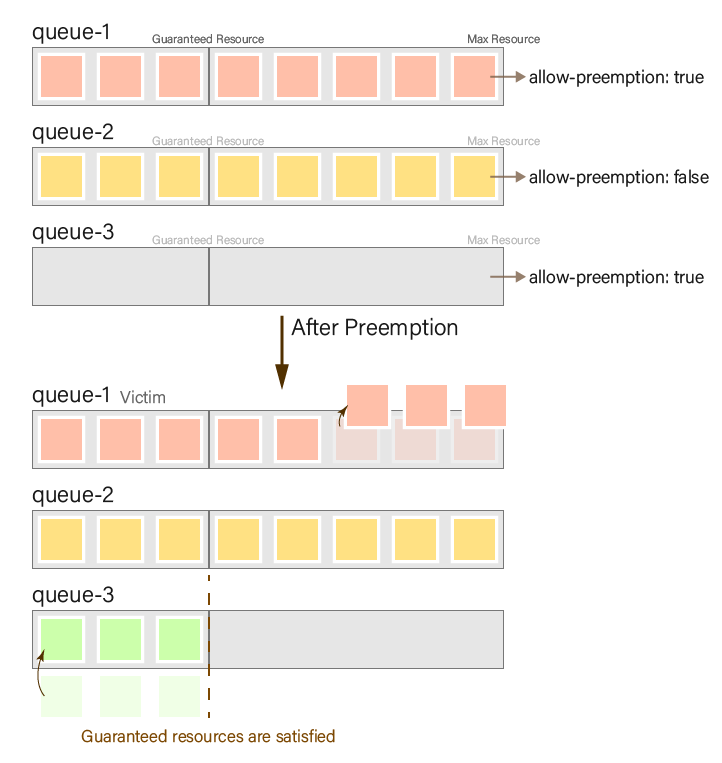
Priority Queue
In addition to utilizing the default PriorityClass in Kubernetes, you can configure priorities directly on a YuniKorn queue.
In the following example, we will demonstrate preemption based on queue priority.
We will deploy five pods with a resource demand of 3 in the high-pri queue, norm-pri queue, and low-pri queue, respectively. We will deploy them to the norm-pri queue first, ensuring that the resources in the root(parent queue) will be fully utilized. This will result in uneven resource distribution among the queues, triggering preemption.
| Queue | Max Resource | Guaranteed Resource | priority.offset |
|---|---|---|---|
root | 18 | - | |
root.high-pri | 10 | 6 | 100 |
root.norm-pri | 18 | 6 | 0 |
root.low-pri | 10 | 6 | -100 |
Result:
A queue with higher priority can preempt resources from a queue with lower priority, and preemption stops when the queue has preempted enough resources to satisfy its guaranteed resources.
| Queue | Resource before preemption | Resource after preemption |
|---|---|---|
root.high-pri | 0 | 6 (guaranteed minimum) |
root.norm-pri | 18 (victim) | 12 |
root.low-pri | 0 | 0 |
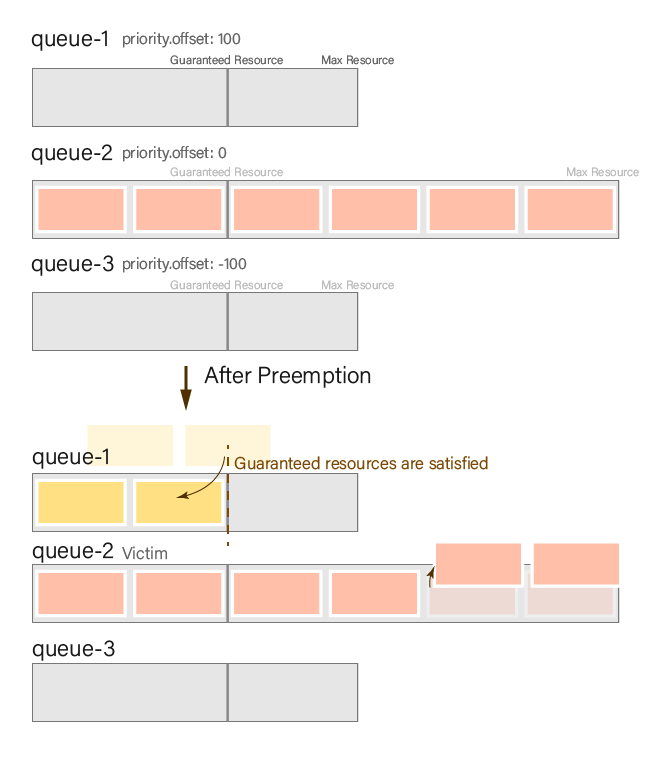
Preemption Fence
In a multi-tenant environment, it is essential to prevent one tenant from occupying the resources of another tenant. In YuniKorn, we map tenants to a queue hierarchy, the queue hierarchy can thus cross tenant boundaries.
To address this issue, YuniKorn introduces a preemption fence, which is a setting on the queue that prevents preemption from looking at queues outside the fence boundary. The fence is a one-way fence. It prevents going out (i.e. higher up the queue hierarchy), but does not prevent coming in (or down) the queue hierarchy.
...
queues:
- name: default
properties:
preemption.policy: fence
We will use the following diagram as an example:
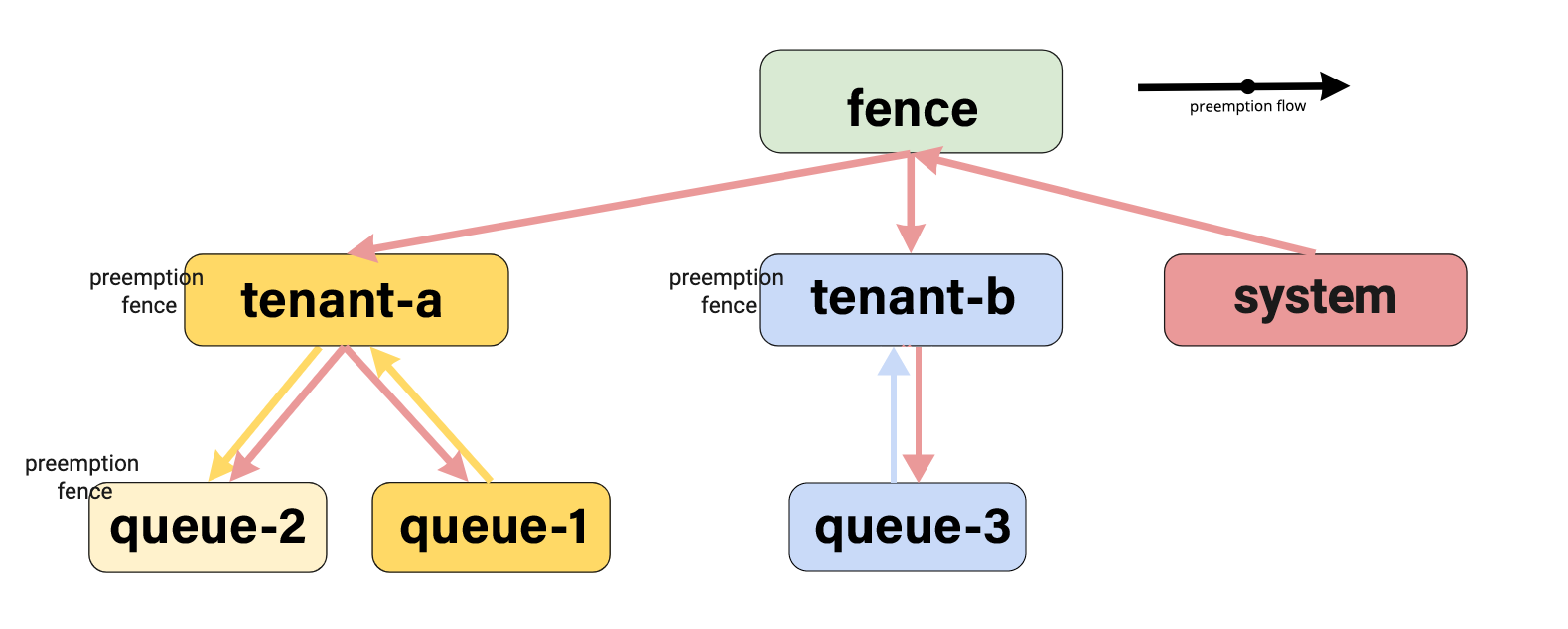
In this example, we will sequentially deploy 15 pods with a resource requirement of 1 to each sub-queue.
First, we deploy queue-1 in tenant-a and wait until the application in queue-1 occupies all the resources of tenant-a. Then, we deploy queue-2 after the resources of tenant-a are fully utilized. Next, we deploy the application ten-b.queue-3 and allocate resources to the system when the fence queue is full.
| Queue | Max Resource | Guaranteed Resource | fence |
|---|---|---|---|
rt | 3 | - | true |
rt.ten-a | 15 | 5 | true |
rt.ten-a.queue-1 | 15 | 2 | |
rt.ten-a.queue-2 | 15 | 2 | true |
rt.ten-b | 15 | 10 | true |
rt.ten-b.queue-3 | 15 | 10 | |
rt.sys | 15 | 10 |
Result:
In this example, two imbalances are observed:
- Within
ten-a,queue-1occupies all the resources, whilequeue-2has no resources. However, sincequeue-2is configured with a fence, it cannot acquire resources from outside the fence.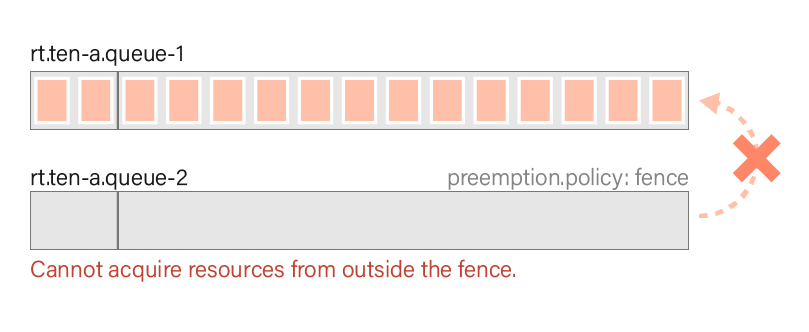
- Inside the
rtqueue, bothten-aandten-boccupy all the resources, while thesysqueue has no resources, and no fence is set up. Therefore, thesysqueue can acquire resources from the queues in the hierarchy until its guaranteed resources are met. In this case, thesysqueue acquires resources from bothten-aandten-b.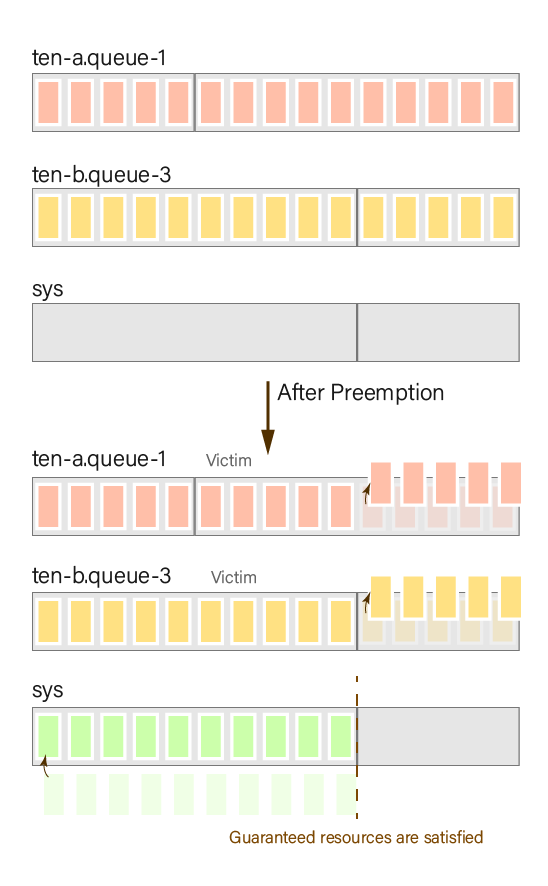
| Queue | Resource before preemption | Resource after preemption |
|---|---|---|
rt.ten-a | 15 | 10 |
rt.ten-a.queue-1 | 15 | 10 |
rt.ten-a.queue-2 | 0 | 0 |
rt.ten-b | 15 | 10 |
rt.ten-b.queue-3 | 15 | 10 |
rt.sys | 0 | 10 |
Redistribution of Quota and Preemption Storm
Redistribution of Quota
Setting up guaranteed resources for the queue present at a higher level in the queue hierarchy helps to re-distribute the quota among different groups. Especially when workloads of the same priority run in different groups, unlike the default scheduler, YuniKorn preempts workloads of the same priority to free up resources for pending workloads who deserve to get the resources as per the queues guaranteed quota. At times, one needs this kind of queue setup in a real production cluster for redistribution.
For example, root.region[1-N].country[1-N].state[1-N]
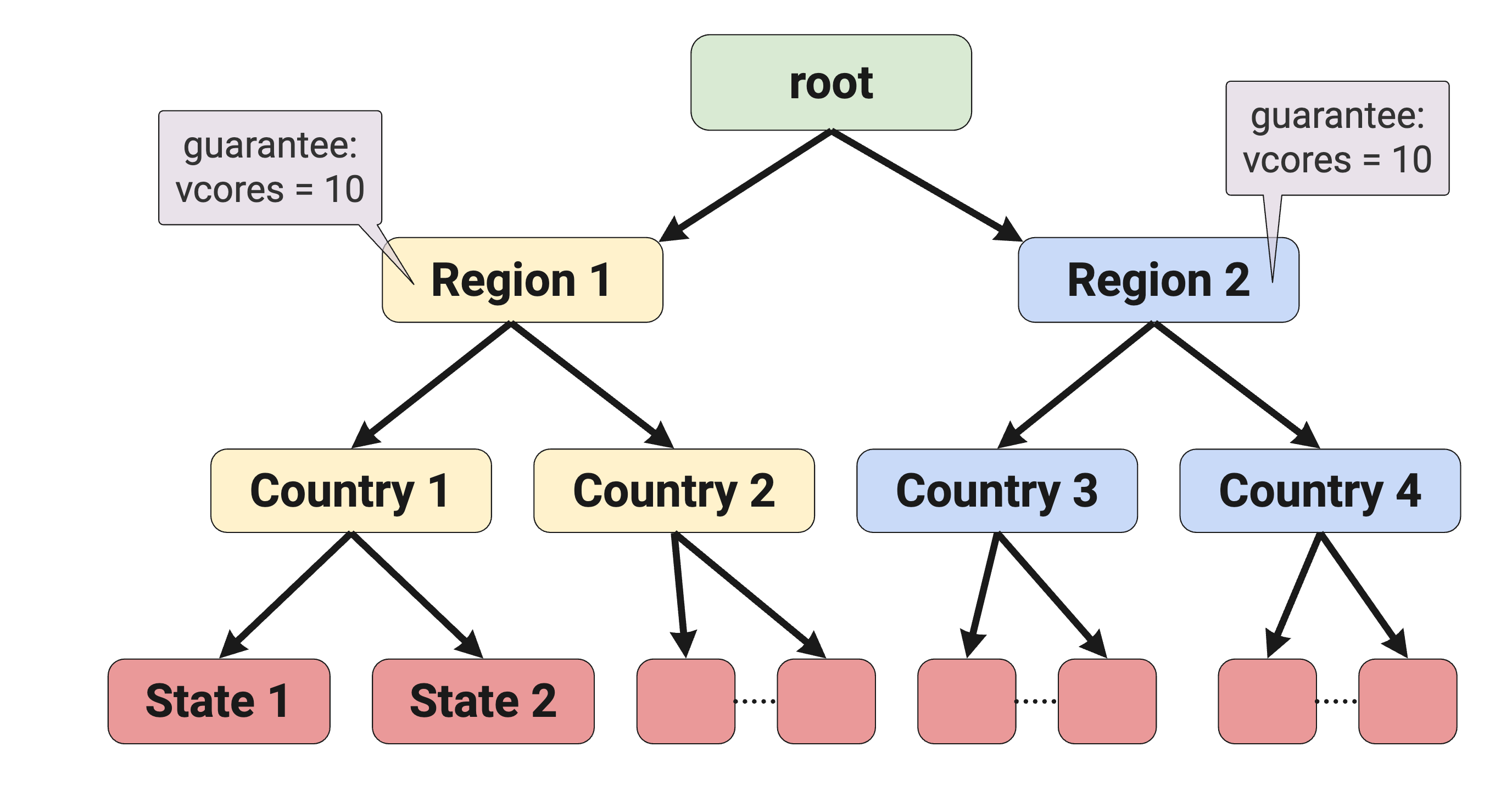
This queue setup has N regions under “root”, each region has N countries. If administrators want to redistribute the workloads of the same priority among different regions, then it is better to define the guaranteed quota for each region so that preemption helps to reach the situation of running the workloads by redistribution based on the guaranteed quota each region is supposed to get. That way each region uses the resources it deserves to get at the maximum possible level from the overall cluster resources.
Preemption Storm
With a setup like above, there is a side effect of increasing the chance of a preemption storm or loop happening within the specific region between different state queues (siblings belonging to same parent).
ReplicaSets are a good example to look at for looping and circular preemption. Each time a pod from a replica set is removed the ReplicaSet controller will create a new pod to make sure the set is complete. That auto-recreation could trigger loops as described below.
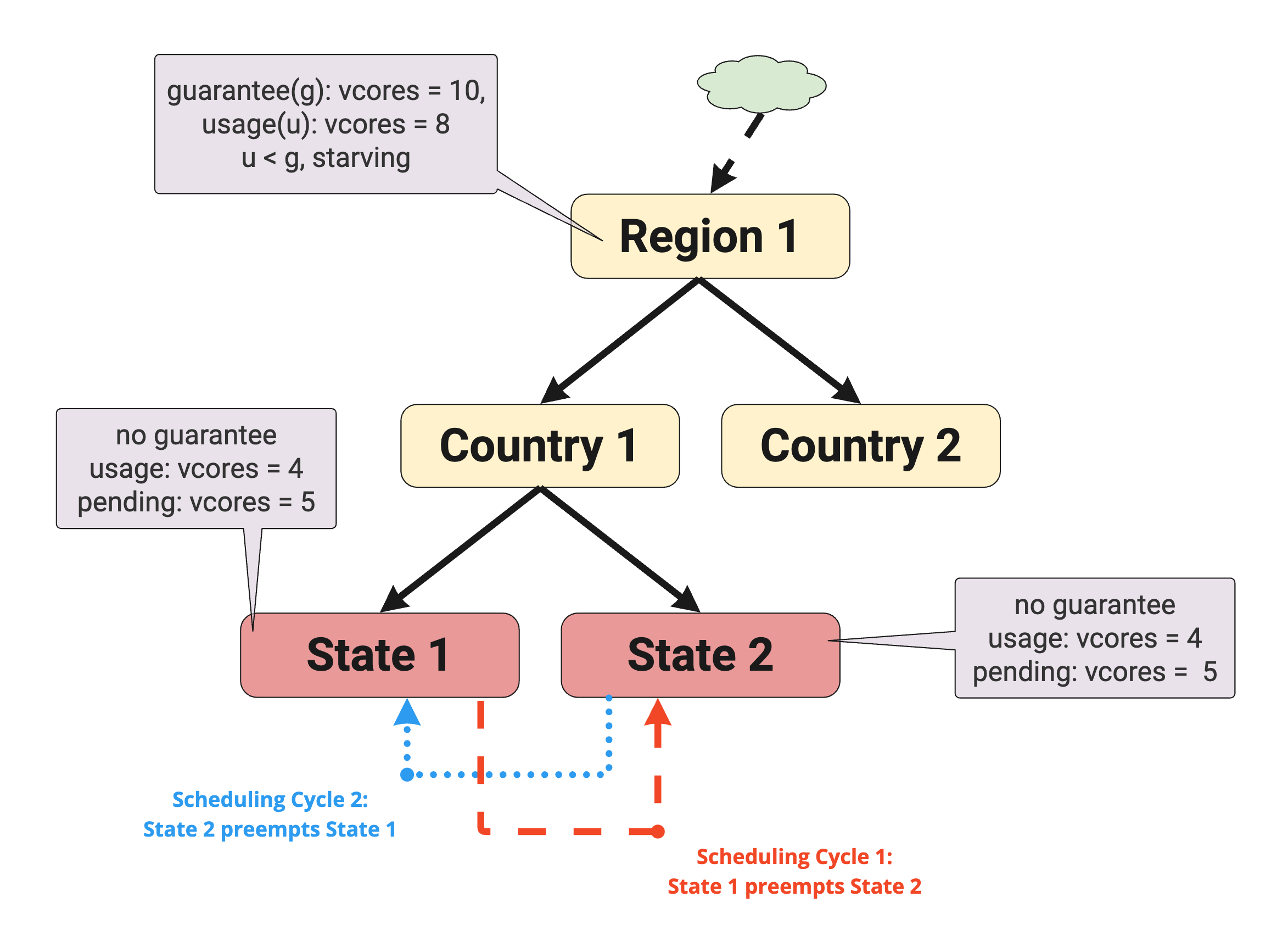
State of the queues:
Region1
- Guaranteed: vcores = 10
- Usage: vcores = 8
- Under guaranteed: usage < guaranteed, starving
State1
- Guaranteed: nil
- A ReplicaSet is submitted to queue and requesting 9 replicas, with each replica requiring
{vcores: 1}. - 4 replicas are running. Usage: vcores = 4
- 5 replicas are waiting for resources. Pending: vcores = 5
- Inherits "under guaranteed" behaviour from
Region1, eligible to trigger preemption
State2
- Guaranteed: nil
- A ReplicaSet is submitted to queue and requesting 9 replicas, with each replica requiring
{vcores: 1}. - 4 replicas are running. Usage: vcores = 4
- 5 replicas are waiting for resources. Pending: vcores = 5
- Inherits "under guaranteed" behaviour from
Region1, eligible to trigger preemption
Replica set State1 Repl runs in queue State1. Replica set State2 Repl runs in the queue State2. Both queues belong to the same parent queue (they are siblings), Country1. The pods all run with the same settings for priority and preemption. There is no space left on the cluster. Both region, Region1 and country, Country1 queue usage is {vcores:8}. Since Region1 has a guaranteed quota of {vcores:10} and usage of {vcores:8} lower than its guaranteed quota leading to starvation of resources. All the queues (including both direct or indirect) below the parent queue are starving as it inherits the “under guaranteed” behavior from above said parent queue, Region1 calculation unless each state (leaf) queue has its own guaranteed quota. Now, either one of these state queues can trigger preemption.
Let's say, state1 triggers preemption to meet resource requirements for pending pods.
To make room for a State1 Repl pod, a pod from the State2 Repl set is preempted. Now, the pending State1 Repl pod moves from pending to running. Now, the next scheduling cycle comes. Let's say, State2 triggers preemption to meet resource requirements for its pending pods. In addition to already existing pending pods, pod preempted (killed) in earlier scheduling cycles would have been recreated automatically by this time as it is a replica set. To make room for a State2 Repl pod, a pod from the State1 Repl set is preempted. Now, the pending State2 Repl pod moves from pending to running and preempted (killed) pod belonging to State1 Repl set would be recreated again. Now, the next scheduling cycle comes. Again, the whole loop repeats killing each other from the siblings without going anywhere leading to a preemption storm causing instability of the queues. It could even happen for a child queue below Country2 that gets caught in the preemption storm.
Defining guaranteed resources at queues at lower level or at end leaf queues can avoid the preemption storm or loop from happening in the cluster. Administrators should be aware of the side effects of setting up guaranteed resources at any specific location in the queue hierarchy to reap the best possible outcomes of the preemption process.